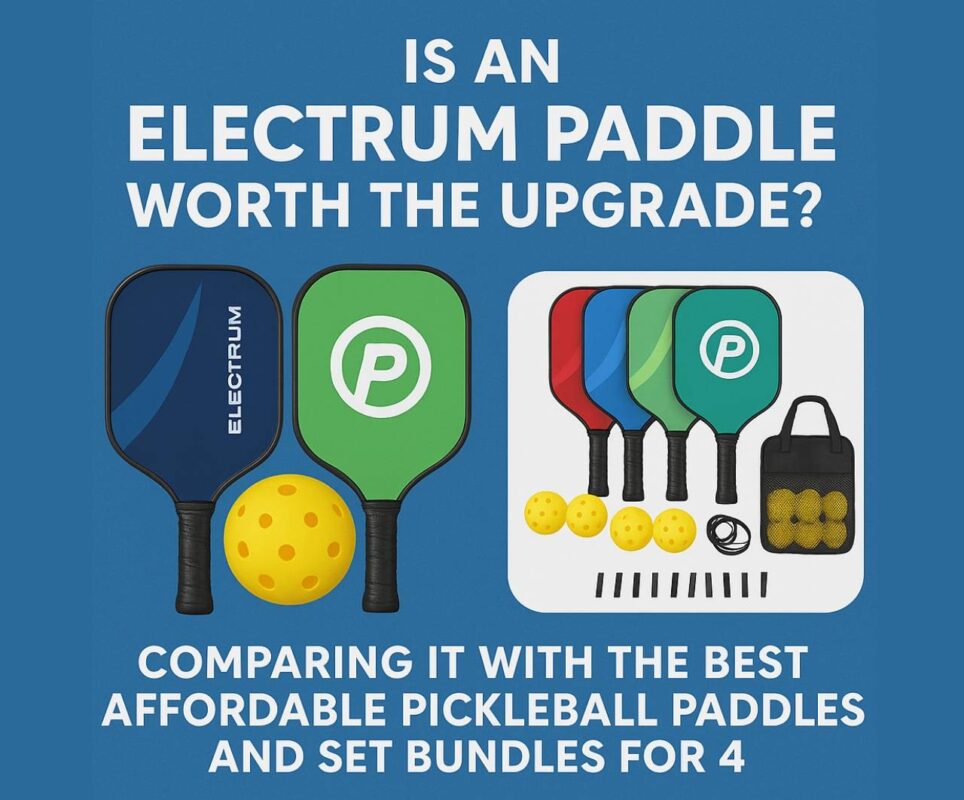If you’re just stepping into the exciting world of pickleball, finding your first pickleball paddle can feel overwhelming. With so many options on the market, each boasting different materials, weights, and designs, it’s natural to feel uncertain. That’s why we’ve created this comprehensive beginner pickleball paddle guide to help you understand the essentials and make an informed choice. In this guide, we will walk you through everything you need to know about how to choose a pickleball paddle, so your first purchase sets you up for success on the court. Know more..
Why Choosing the Right Paddle Matters
Your pickleball paddle is more than just equipment—it’s an extension of your playing style. Choosing the right paddle impacts your comfort, control, and overall performance. For beginners, a paddle that feels too heavy or has an unusual grip can cause frustration or even strain injuries. Conversely, a well-suited paddle boosts confidence, improves your shot accuracy, and enhances your enjoyment of the game.
When learning how to choose a pickleball paddle, it’s essential to consider key factors like weight, grip, material, and paddle shape. These elements work together to match your play style and physical comfort, making your first experience much smoother and more enjoyable.
Weight: Finding the Perfect Balance
One of the most crucial aspects of your first pickleball paddle is its weight. Paddles are generally categorized into three weight classes:
- Lightweight Paddles (6.5–7.2 oz): Ideal for beginners who prioritize control and quick reflexes. Lightweight paddles reduce arm fatigue and allow for faster swings, which is helpful if you are still developing proper technique.
- Medium-weight Paddles (7.3–8.4 oz): A versatile option suitable for players who want a balance of power and control. Medium paddles are a popular choice for most recreational players.
- Heavyweight Paddles (8.5–9.5 oz): Offer more power on your shots but require more strength and can cause quicker fatigue. Heavy paddles are less recommended for first-time players unless you prefer a power-focused play style.
When following a beginner pickleball paddle guide, trying out different weights in-store or borrowing from friends can help you understand which weight feels natural. Remember, comfort comes first—your paddle should feel like an extension of your arm, not a burden.
Grip Size: Comfort Is Key
Grip size is another vital factor when learning how to choose a pickleball paddle. The right grip ensures that your hand doesn’t slip, reduces the risk of injury, and allows for smoother strokes.
- Small Grip (4–4 1/8 inches): Provides more wrist action for spin but can cause discomfort if your hands are large.
- Medium Grip (4 1/4–4 3/8 inches): The most common choice, suitable for most adults.
- Large Grip (4 1/2–4 5/8 inches): Offers extra stability but reduces wrist mobility, which can affect spin shots.
Your first pickleball paddle should have a grip that feels natural when you hold it with a relaxed but firm hand. Many beginners find that a medium grip provides the best balance between control and comfort.
Paddle Material: Poly, Wood, or Composite?
Another essential part of your beginner pickleball paddle guide is understanding paddle materials. The choice of material affects your game in terms of control, power, and durability.
- Wood Paddles: Often the most affordable and durable, wood paddles are heavier and less forgiving for beginners. They’re a good choice if you are just trying out the sport and on a tight budget.
- Polymer Core Paddles: Lightweight and quiet, polymer paddles are excellent for beginners who want more control and a softer feel. They absorb impact well, reducing stress on your arm.
- Composite Paddles: Made from a combination of materials like fiberglass or carbon fiber with a polymer core, these paddles offer a balance of power, control, and lightweight handling. Composite paddles are often the most popular choice among new players ready to invest a bit more.
Understanding the material helps answer the question of how to choose a pickleball paddle that complements your playing style. Beginners usually benefit from polymer or composite paddles because they offer forgiveness, control, and ease of handling.
Paddle Shape and Size: Traditional vs. Elongated
Paddle shape can affect both reach and sweet spot performance. Here’s what beginners should know:
- Traditional Paddles: Wider with a standard length, offering a larger sweet spot. Ideal for beginners as it increases the chances of hitting the ball effectively.
- Elongated Paddles: Longer and narrower, providing extra reach and leverage for power shots. These paddles require more precision and are better suited for advanced players.
Your first pickleball paddle is usually best as a traditional shape since it maximizes comfort and makes it easier to learn proper strokes.
Control vs. Power: What to Prioritize
When learning how to choose a pickleball paddle, beginners often struggle between choosing control-oriented or power-oriented paddles. Here’s the difference:
- Control Paddles: Lighter, smaller sweet spot, and softer material. They make it easier to place the ball accurately but require slightly more effort to hit powerful shots.
- Power Paddles: Heavier, harder material, larger sweet spot. They hit the ball harder with less effort but may sacrifice precision and cause more strain on your wrist and elbow.
For your first pickleball paddle, control is typically the preferred choice. It allows you to develop technique, timing, and consistency without relying solely on brute force. Once you gain confidence, experimenting with power paddles can add versatility to your game.
Popular Brands and Models for Beginners
Several paddle brands are particularly beginner-friendly. Here are some options to explore in your beginner pickleball paddle guide:
- Selkirk Prime S2: Lightweight, durable, and excellent for control.
- ONIX Z5 Graphite: Versatile, balanced, and suitable for a wide range of players.
- Paddletek Bantam EX-L: Known for a polymer core that absorbs impact and provides soft control.
Trying different models allows you to feel the differences and find a paddle that suits your style and comfort.
Testing Your Paddle: Try Before You Buy
One of the best tips in any beginner pickleball paddle guide is to test paddles before committing. Visit a local pickleball club or sports store to try different weights, grips, and materials. Pay attention to:
- How the paddle feels in your hand
- How easy it is to maneuver during volleys
- How it handles both soft and power shots
Testing helps you answer how to choose a pickleball paddle in a hands-on way, ensuring your first purchase is a paddle you’ll enjoy using for years.
Maintenance Tips for Your First Paddle
Even a beginner needs to know how to care for their first pickleball paddle. Simple maintenance extends the life of your paddle:
- Avoid exposing your paddle to extreme temperatures or moisture.
- Clean it with a damp cloth after playing to remove dirt and sweat.
- Check your grip regularly and replace it when worn for comfort and safety.
Proper care helps your paddle maintain performance and gives you a consistent experience on the court.
Final Thoughts
Choosing your first pickleball paddle doesn’t have to be complicated. By following this beginner pickleball paddle guide and paying attention to weight, grip, material, shape, and control vs. power, you can find a paddle that feels like an extension of your own hand. Remember, the right paddle boosts your confidence, improves your game, and makes your pickleball journey more enjoyable.
Always prioritize comfort and control over brand hype or looks, especially when starting out. Once you develop your skills, you can experiment with different paddle types, shapes, and materials to refine your play style.
If you’re asking yourself how to choose a pickleball paddle, remember: test before buying, understand your preferences, and invest in a paddle that encourages your growth as a player. With the right paddle, your pickleball experience will be more enjoyable, and you’ll be well on your way to becoming a confident competitor on the court.





